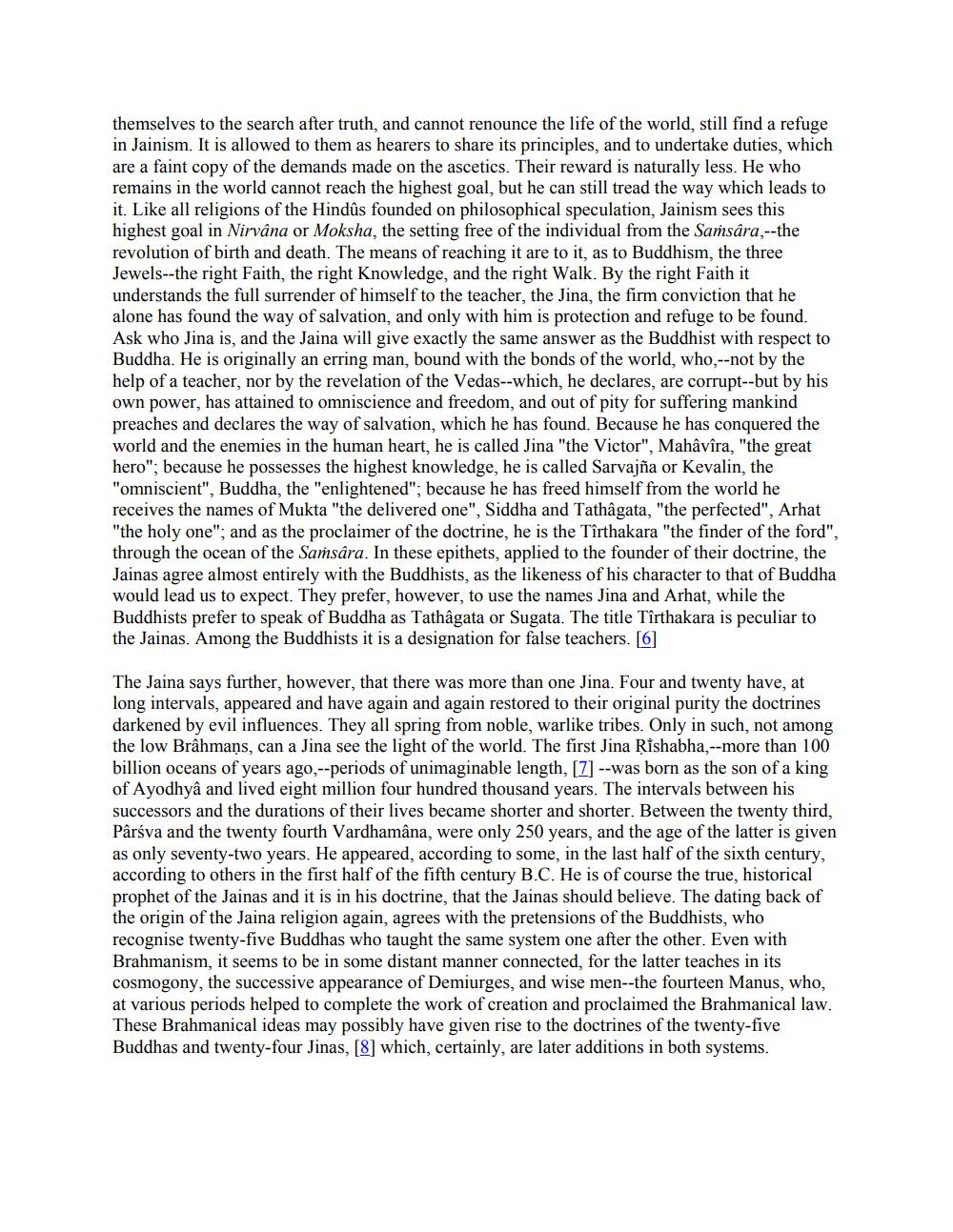Book Title: On Indian Sect of Jainas Author(s): Jas Burgess Publisher: Jas Burgess View full book textPage 4
________________ themselves to the search after truth, and cannot renounce the life of the world, still find a refuge in Jainism. It is allowed to them as hearers to share its principles, and to undertake duties, which are a faint copy of the demands made on the ascetics. Their reward is naturally less. He who remains in the world cannot reach the highest goal, but he can still tread the way which leads to it. Like all religions of the Hindûs founded on philosophical speculation, Jainism sees this highest goal in Nirvana or Moksha, the setting free of the individual from the Samsára,--the revolution of birth and death. The means of reaching it are to it, as to Buddhism, the three Jewels--the right Faith, the right Knowledge, and the right Walk. By the right Faith it understands the full surrender of himself to the teacher, the Jina, the firm conviction that he alone has found the way of salvation, and only with him is protection and refuge to be found. Ask who Jina is, and the Jaina will give exactly the same answer as the Buddhist with respect to Buddha. He is originally an erring man, bound with the bonds of the world, who,--not by the help of a teacher, nor by the revelation of the Vedas--which, he declares, are corrupt--but by his own power, has attained to omniscience and freedom, and out of pity for suffering mankind preaches and declares the way of salvation, which he has found. Because he has conquered the world and the enemies in the human heart, he is called Jina "the Victor", Mahâvîra, "the great hero"; because he possesses the highest knowledge, he is called Sarvajña or Kevalin, the "omniscient", Buddha, the "enlightened", because he has freed himself from the world he receives the names of Mukta "the delivered one", Siddha and Tathagata, "the perfected", Arhat "the holy one", and as the proclaimer of the doctrine, he is the Tîrthakara "the finder of the ford", through the ocean of the Samsára. In these epithets, applied to the founder of their doctrine, the Jainas agree almost entirely with the Buddhists, as the likeness of his character to that of Buddha would lead us to expect. They prefer, however, to use the names Jina and Arhat, while the Buddhists prefer to speak of Buddha as Tathagata or Sugata. The title Tîrthakara is peculiar to the Jainas. Among the Buddhists it is a designation for false teachers. [6] The Jaina says further, however, that there was more than one Jina. Four and twenty have, at long intervals, appeared and have again and again restored to their original purity the doctrines darkened by evil influences. They all spring from noble, warlike tribes. Only in such, not among the low Brahmans, can a Jina see the light of the world. The first Jina Rishabha --more than 100 billion oceans of years ago,--periods of unimaginable length, [Z] --was born as the son of a king of Ayodhyâ and lived eight million four hundred thousand years. The intervals between his successors and the durations of their lives became shorter and shorter. Between the twenty third, Parsva and the twenty fourth Vardhamâna, were only 250 years, and the age of the latter is given as only seventy-two years. He appeared, according to some, in the last half of the sixth century, according to others in the first half of the fifth century B.C. He is of course the true, historical prophet of the Jainas and it is in his doctrine, that the Jainas should believe. The dating back of the origin of the Jaina religion again, agrees with the pretensions of the Buddhists, who recognise twenty-five Buddhas who taught the same system one after the other. Even with Brahmanism, it seems to be in some distant manner connected, for the latter teaches in its cosmogony, the successive appearance of Demiurges, and wise men--the fourteen Manus, who, at various periods helped to complete the work of creation and proclaimed the Brahmanical law. These Brahmanical ideas may possibly have given rise to the doctrines of the twenty-five Buddhas and twenty-four Jinas, [8] which, certainly, are later additions in both systems.Page Navigation
1 2 3 4 5 6 7 8 9 10 11 12 13 14 15 16 17 18 19 20 21 22 23 24 25 26 27 28 29 30 31 32 33 34 35 36 37 38 39 40
